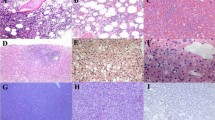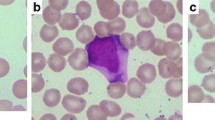Abstract
We performed a retrospective analysis of patients with adult-onset chronic active Epstein–Barr virus infection (CAEBV). First, we analyzed five patients (aged 28–72) diagnosed at our hospitals with EBV-infected clonally proliferating T cells. Four patients were administered cyclophosphamide/doxorubicin/vincristine/prednisone (CHOP) chemotherapy, but no remarkable decrease of viral load was observed in three of the patients. The other patient died 19 days after initiation of CHOP treatment due to disease progression. Addition of high-dose cytarabine to the regimens of two of the patients was discontinued shortly after administration, due to the development of grade 4 pericardial effusion. Together, these regimens may be insufficient for treating adult-onset CAEBV. We next reviewed 23 adult-onset CAEBV patients, adding 18 previously reported patients to the five patients described in the present study. T cells were frequently infected (87%), whereas NK- and T-cell types are known to be almost equally prevalent in childhood-onset cases. The time duration from the onset of disease to initiation of treatment averaged 20 months. Reports showed that 12 patients died; seven patients died at an average of 8 months after initiation of treatment. Patients’ disease courses seemed to be rapidly progressive and more aggressive than those of childhood-onset cases. More cases must be studied to clarify clinical features and establish an optimal treatment strategy.
Similar content being viewed by others
References
Okano M, Kawa K, Kimura H, Yachie A, Wakiguchi H, Maeda A, et al. Proposed guidelines for diagnosing chronic active Epstein–Barr virus infection. Am J Hematol. 2005;80:64–9.
Quintanilla-Martinez L, Kimura H, Jaffe ES. EBV-positive T-cell lymphoproliferative disorders of childhood. In: Jaffe ES, Harris NL, Stein H, Vardiman JW, editors. World Health Organization Classification of Tumors. Pathology and Genetics of Tumours of Haematopoietic and Lymphoid Tissues. Lyon: IARC Press; 2008. p. 278–80.
Ohshima K, Kimura H, Yoshino T, Kim CW, Ko YH, Lee SS, et al. Proposed categorization of pathological states of EBV-associated T/natural killer-cell lymphoproliferative disorder (LPD) in children and young adults: overlap with chronic active EBV infection and infantile fulminant EBV T-LPD. Pathol Int. 2008;58:209–17.
Sato E, Ohga S, Kuroda H, Yoshiba F, Nishimura M, Nagasawa M, et al. Allogeneic hematopoietic stem cell transplantation for Epstein–Barr virus-associated T/natural killer-cell lymphoproliferative disease in Japan. Am J Hematol. 2008;83:721–7.
Imadome K, Shimizu N, Arai A, Miura O, Watanabe K, Nakamura H, et al. Coexpression of CD40 and CD40 ligand in Epstein–Barr virus-infected T and NK cells and their role in cell survival. J Infect Dis. 2005;192:1340–8.
Koyama M, Takeshita Y, Sakata A, Sawada A, Yasui M, Okamura T, et al. Cytotoxic chemotherapy successfully induces durable complete remission in 2 patients with mosquito allergy resulting from Epstein–Barr virus-associated T-/natural killer cell lymphoproliferative disease. Int J Hematol. 2005;82:437–40.
Fujii N, Takenaka K, Hiraki A, Maeda Y, Ikeda K, Shinagawa K, et al. Allogeneic peripheral blood stem cell transplantation for the treatment of chronic active Epstein–Barr virus infection. Bone Marrow Transplant. 2000;26:805–8.
Sato-Matsumura KC, Matsumura T, Kobayashi H, Fujimoto K, Itoh T, Shimizu M, et al. Marked swollen erythema of the face together with sicca syndrome as a sign for chronic active Epstein–Barr virus infection. Br J Dermatol. 2000;143:1351–3.
Kimura H, Hoshino Y, Kanegane H, Tsuge I, Okamura T, Kawa K, et al. Clinical and virologic characteristics of chronic active Epstein–Barr virus infection. Blood. 2001;98:280–6.
Hauptmann S, Meru N, Schewe C, Jung A, Hiepe F, Burmester G, et al. Fatal atypical T-cell proliferation associated with Epstein–Barr virus infection. Br J Haematol. 2001;112:377–80.
Ogawa J, Koike R, Sugihara T, Hagiyama H, Nishio J, Kohsaka H, et al. An autopsied case of chronic active Epstein–Barr virus infection complicated in systemic lupus erythematosus and antiphospholipid antibody syndrome. Nihon Rinsho Meneki Gakkai Kaishi. 2002;25:458–65.
Shirasaki F, Taniuchi K, Matsushita T, Hamaguhi Y, Takata M, Takehara K. Epstein–Barr virus-associated T-cell lymphoma: a case of eyelid swelling and intramuscular infiltration mimicking dermatomyositis. Br J Dermatol. 2002;147:1244–8.
Yoshiba F, Hagihara M, Tazume K, Ogawa Y, Kishi K, Higuchi A, et al. Complete resolution of severe chronic active Epstein–Barr virus infection by cultured, activated donor T lymphocyte infusion after nonmyeloablative stem cells allografting. Bone Marrow Transplant. 2003;32:107–10.
Ogata M, Imamura T, Mizunoe S, Ohtsuka E, Kikuchi H, Nasu M. Natural killer cell-type body cavity lymphoma following chronic active Epstein–Barr virus infection. Am J Hematol. 2003;73:126–30.
Shibuya A, Tsuchihashi T, Watanabe M, Nakazawa T, Takeuchi A, Sakurai K, et al. Severe chronic active Epstein–Barr virus infection associated with multiple necrotic lesions in the liver. Hepatol Res. 2003;25:447–54.
Uchiyama T, Arai K, Yamamoto-Tabata T, Hirai K, Kishimoto K, Nakamura Y, et al. Generalized myositis mimicking polymyositis associated with chronic active Epstein–Barr virus infection. J Neurol. 2005;252:519–25.
Kobayashi Z, Tsuchiya K, Takahashi M, Yokota O, Sasaki A, Bhunchet E, et al. An autopsy case of chronic active Epstein–Barr virus infection (CAEBV): distribution of central nervous system (CNS) lesions. J Neurol Sci. 2008;275:170–7.
Sonke GS, Ludwig I, van Oosten H, Baars JW, Meijer E, Kater AP, et al. Poor outcomes of chronic active Epstein–Barr virus infection and hemophagocytic lymphohistiocytosis in non-Japanese adult patients. Clin Infect Dis. 2008;47:105–8.
Gotoh K, Ito Y, Shibata-Watanabe Y, Kawada J, Takahashi Y, Yagasaki H, et al. Clinical and virological characteristics of 15 patients with chronic active Epstein–Barr virus infection treated with hematopoietic stem cell transplantation. Clin Infect Dis. 2008;46:1525–34.
Takano H, Nakagawa K, Ishio N, Daimon M, Kobayashi Y, Hiroshima K, et al. Active myocarditis in a patient with chronic active Epstein–Barr virus infection. Int J Cardiol. 2008;130:e11–3.
Imashuku S, Azuma N, Kanegane H, Kasahara Y. M-protein-positive chronic active Epstein–Barr virus infection: features mimicking HIV-1 infection. Int J Hematol. 2009;90:235–8.
Kimura H, Morishima T, Kanegane H, Ohga S, Hoshino Y, Maeda A, et al. Prognostic factors for chronic active Epstein–Barr virus infection. J Infect Dis. 2003;187:527–33.
Miller TP, Dahlberg S, Cassady JR, Adelstein DJ, Spier CM, Grogan TM, et al. Chemotherapy alone compared with chemotherapy plus radiotherapy for localized intermediate- and high-grade non-Hodgkin’s lymphoma. N Engl J Med. 1998;339:21–6.
Capizzi RL, Davis R, Powell B, Cuttner J, Ellison RR, Cooper MR, et al. Synergy between high-dose cytarabine and asparaginase in the treatment of adults with refractory and relapsed acute myelogenous leukemia—a Cancer and Leukemia Group B Study. J Clin Oncol. 1988;6:499–508.
Ek T, Jarfelt M, Mellander L, Abrahamsson J. Proinflammatory cytokines mediate the systemic inflammatory response associated with high-dose cytarabine treatment in children. Med Pediatr Oncol. 2001;37:459–64.
Acknowledgments
This work was supported by a grant from the Ministry of Health, Labor and Welfare of Japan.
Conflict of interest
The authors declare no competing financial interests.
Author information
Authors and Affiliations
Corresponding author
About this article
Cite this article
Arai, A., Imadome, KI., Watanabe, Y. et al. Clinical features of adult-onset chronic active Epstein–Barr virus infection: a retrospective analysis. Int J Hematol 93, 602–609 (2011). https://doi.org/10.1007/s12185-011-0831-x
Received:
Revised:
Accepted:
Published:
Issue Date:
DOI: https://doi.org/10.1007/s12185-011-0831-x




